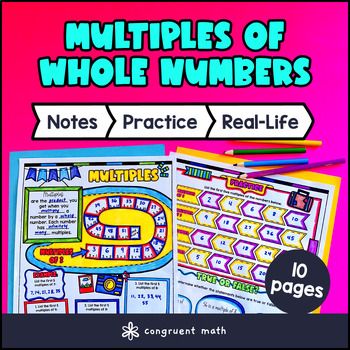Want more ideas and freebies?
Get my free resource library with digital & print activities—plus tips over email.
Join for Free Resources →
$4.25
Ever wondered how to teach multiples in an engaging way to your 4th grade students?
In this lesson plan, students will learn about multiples of whole numbers and their real-life applications. Through artistic, interactive guided notes, checks for understanding, a maze activity, and practice worksheets, students will gain a comprehensive understanding of multiples.
The lesson concludes with a real-life example that explores how multiples are applied in manufacturing and resource management.

$4.25
After this lesson, students will be able to:
Before this lesson, students should be familiar with:
As a hook, ask students if they have ever noticed patterns when counting by certain numbers, like counting by 2s, 5s, or 10s. Encourage them to share examples from daily life such as counting groups of objects or steps in a dance.
Use the first page of the guided notes to introduce the concept of multiples of whole numbers. Walk through the definition of a multiple, emphasizing that a multiple is the product of a number and any whole number. Guide students to identify multiples of different numbers with provided examples and point out the relationship between skip counting and multiples. Make sure to pause for the embedded checks for understanding, asking students to explain the concept in their own words and to provide examples.
Use the second page of the guided notes to deepen understanding by having students find the multiples of a few numbers listed there. Walk through the examples illustrating how to generate lists of multiples and how to check if a number is a multiple of another. Refer to the FAQ below for ways to clarify common misconceptions, such as confusing multiples with factors or thinking multiples must be just listed in order.
Based on student responses during these checks for understanding, reteach any concepts that students find challenging—whether that’s the definition of multiples, the process of finding them, or interpreting their real-life significance. For classes with varied levels of proficiency, consider pulling small groups for targeted reteaching while encouraging more advanced students to begin previewing the practice exercises or create additional sets of multiples on their own.
Have students practice finding multiples of whole numbers using the maze activity (page 3) included in this resource. Walk around to answer student questions.
Fast finishers can start the color by number activity (page 4) for extra practice. You can assign it as homework for the remainder of the class.
Using the last page of the resource, bring the class back together, and introduce the concept of how multiples are used in manufacturing to create products efficiently. Explain that in factories, items are often produced in batches or groups that are multiples of a certain number to simplify packaging, shipping, and inventory management. Discuss examples such as packing items in boxes of 6, 12, or 24, and how understanding multiples helps workers and managers keep track of quantities. Refer to the FAQ for more ideas on how to teach it!
If you’re looking for digital practice for finding multiples and factors, try my Pixel Art activities in Google Sheets. Every answer is automatically checked, and correct answers unlock parts of a mystery picture. It’s incredibly fun, and a powerful tool for differentiation.
Here’s 2 activities to explore:
Multiples are the numbers you get when you multiply a number by whole numbers. For example, multiples of 3 are 3, 6, 9, 12, and so on.
To find multiples of a number, multiply that number by 1, 2, 3, and so forth. For example, to find multiples of 4, calculate 4x1=4, 4x2=8, 4x3=12, and so on.
Multiples help with understanding multiplication, division, and factors. They are also useful for solving problems involving least common multiples and real-life situations such as scheduling or grouping.
Multiples are obtained by multiplying a number by whole numbers, while factors are numbers that divide into a number evenly. In other words:
You can check by dividing the bigger number by the smaller number. If the division leaves no remainder, the bigger number is a multiple of the smaller one.
Multiples show up in many everyday contexts such as:
The Common Core standard 4.OA.C.5 focuses on finding multiples and understanding their relationship to multiplication and division, which helps build a strong foundation for more advanced math concepts.
Engaging activities include:
Get my free resource library with digital & print activities—plus tips over email.
Join for Free Resources →